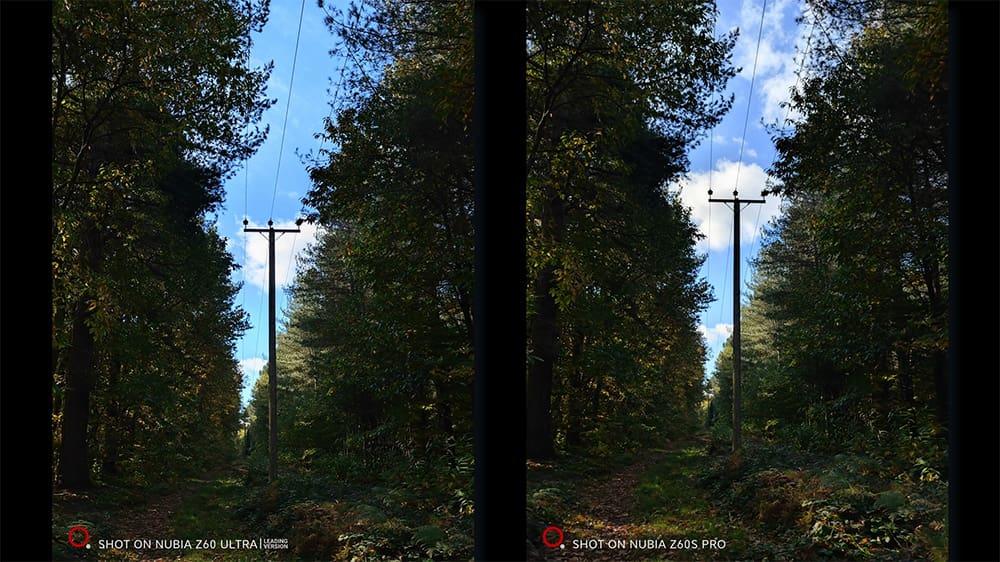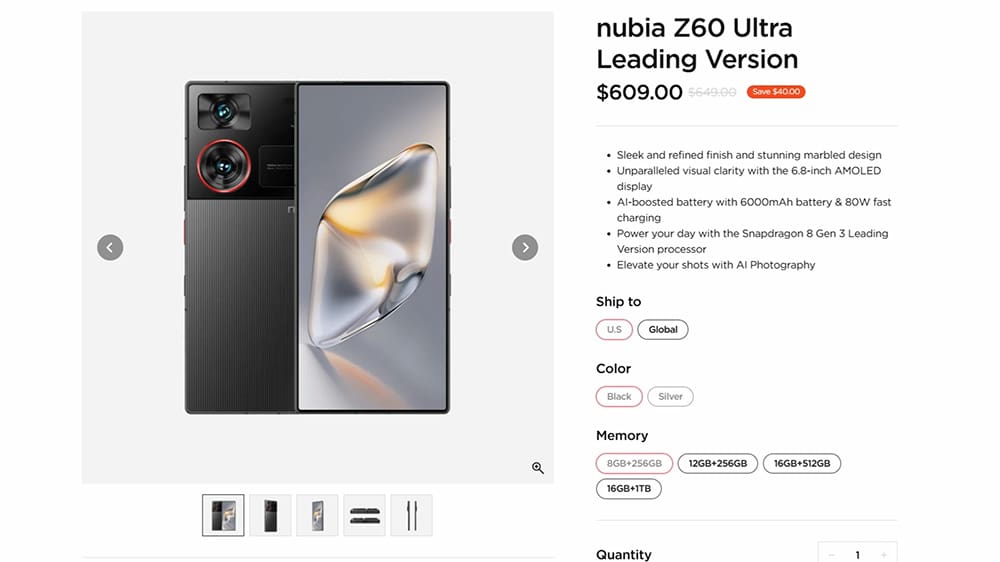Finding the perfect device that balances cutting-edge features and impressive specs in a landscape saturated with smartphones can be daunting. In this post, we dive deep into a compelling comparison of two standout contenders from nubia: the Z60 Ultra Leading Version and the Z60S Pro. Both models showcase the brand’s commitment to innovation and performance but cater to slightly different audiences and use cases.
From camera capabilities to battery life and processor performance, we’ll highlight the key features that set these devices apart. This will help you decide which one best suits your unique needs. Let’s explore what makes the nubia Z60 Ultra Leading Version and the Z60S Pro unique and see how they compare!
Table of Contents
Aesthetics: nubia Z60 Ultra Leading Version vs Z60S Pro
Design
My first impression is that these phones are pretty large. The Ultra model is slightly bulkier, measuring 8.8mm thick and weighing 26g more than the Pro. From a front view, the main distinction is that the Pro has a sleek, rounded appearance with smooth, rounded edges, whereas the Ultra features a design with straighter edges and corners.
Another notable difference is the front-facing camera, often called the selfie camera. On the Pro, it is visible at the top of the screen, providing easy access for quick selfies and video calls. Meanwhile, on the Ultra, it is uniquely concealed beneath the display, offering a sleeker design and a larger uninterrupted screen, setting it apart from the Pro.
Both phones feature prominent cameras on the back that extend beyond the casing, but their designs differ significantly. The Pro model’s rounded design with three cameras grouped together offers a more compact look, while the Ultra model’s three separate camera sections provide a more spread-out aesthetic.
Both phones, with their distinct design styles and textures, are highly effective at resisting fingerprints. Additionally, the Z60 Ultra is IP68-rated for water and dust resistance, a feature the Z60S Pro does not have.
Screen
The Z60 Ultra and the Pro models have very similar screen sizes, with the Z60 Ultra measuring only slightly larger at 6.8mm. Both phones are equipped with high-quality AMOLED displays that boast a refresh rate of 120Hz, ensuring a smooth and vibrant visual experience.
However, there are several key distinctions between the two models. For example, the Ultra supports HDR10 and has a peak brightness of 1500 nits, while the Pro model offers a peak brightness of 1200 nits.
Additionally, the Ultra features a display resolution of 1116 x 2480 pixels, whereas the Pro has a slightly higher resolution of 1260 x 2800 pixels, providing even crisper and more detailed visuals.
Technical Details: nubia Z60 Ultra Leading Version vs Z60S Pro
CPU & RAM
The Z60 Ultra and Z60S Pro have notable differences in their specifications, yet both deliver powerful performance. The Z60 Ultra is powered by the high-performance Qualcomm Snapdragon 8 Gen 3 Leading Version processor, renowned for its exceptional processing capabilities and energy efficiency. In contrast, the Z60S Pro has the Qualcomm Snapdragon 8 Gen 2 processor, offering a balanced combination of performance and energy efficiency.
For RAM, the Z60 Ultra provides options of 8GB, 12GB, or 16GB, catering to various user needs and ensuring smooth multitasking. Meanwhile, the Z60S Pro comes with 12GB or 16GB of RAM, which delivers reliable performance for everyday tasks.
Storage
Connectivity & Software
Both the Z60 Ultra and Z60S Pro support 5G connectivity for high-speed data access and operate on the Android 14 operating system, which includes the latest features and security enhancements.
Additionally, nubia has integrated its custom operating system, MyOS 14, on top of Android 14. MyOS 14 is designed to be free of bloatware, only preinstalling a package of Google apps and a few utilities, resulting in a fast, responsive, and clutter-free user experience.
Battery Life
One reason these phones are bulky and heavy is their large battery size. The Z60 Ultra has a massive 6000mAh battery, which can last two days with regular use. It also features 80W fast charging, enabling it to recharge 39% of the battery in just 22 minutes.
The Z60S Pro has a slightly smaller 5100mAh battery but still provides all-day battery life even with intensive usage. It, too, includes the same 80W fast charging technology.
It’s unfortunate that neither phone supports wireless charging. This is a missed opportunity for added convenience, especially considering the increasing integration of wireless charging technology into our daily lives, such as built-in systems in cars, bedside tables, and even sofas.
Camera: nubia Z60 Ultra Leading Version vs Z60S Pro
Rear Cameras
The nubia Z60 Ultra Leading Version and the nubia Z60S Pro both boast impressive camera systems, but they have some key differences.
The Z60 Ultra Leading Version features a powerful triple-camera setup: a 50MP main camera, a 50MP wide-angle camera, and a 64MP telephoto lens. These high-resolution sensors, coupled with advanced image processing, deliver stunning detail and clarity.
In contrast, the Z60S Pro has a slightly different configuration, including a 50MP main camera, a 50MP ultra-wide camera, and an 8MP telephoto lens. While the resolution is similar, the ultra-wide camera allows for more expansive shots, and the telephoto lens provides better zoom capabilities.
Let’s delve into the versatility of their cameras and the differences between them. After photographing various types of scenery, both phones have proven to be versatile, catering to different needs. I was genuinely impressed with the range of images they produce, from detailed architecture to vibrant landscapes.
When using the 35mm lens to photograph architecture, the nubia Z60 Ultra produces sharper images with greater detail and better contrast than the Z60S Pro. The latter tends to have a white layer that attempts to brighten the photos, which can obscure finer details.
Front (Selfie) Camera
If selfies are your main interest, the Z60S Pro’s 16MP front camera is a clear winner. It significantly outshines the 12MP camera in the Z60 Ultra.
The under-display 12MP front camera on the Z60 Ultra lacks natural colour clarity, resulting in washed-out and blurred photos. This is especially noticeable compared to the clearer, crisper, and more natural images of the 16MP camera on the Z60S Pro.
Therefore, the Z60S Pro is a much better option if you enjoy taking selfies, ensuring your preferences are considered in your smartphone choice.
On the other hand, if design is your priority, the Z60 Ultra features an under-display camera with 6th-generation UDC technology. This design offers users a full-screen experience, giving the device an edge if you seek a truly immersive experience.
Purchase: nubia Z60 Ultra Leading Version vs Z60S Pro
Unboxing
Unboxing the nubia Z60 Ultra Leading Version and the Z60S Pro reveals a carefully curated selection of accessories that accompany these impressive smartphones. Both models come with:
- nubia smartphone
- Quick Start Guide
- SIM tray ejector
- Clear plastic phone case
- Power plug
- Type-C charging cable.
Price
The Z60S Pro provides great value, starting at approximately $500, depending on the selected RAM and storage options.
On the other hand, the nubia Z60 Ultra Leading Version begins at around $609, also varying based on the RAM and storage configurations. Given its specifications and capabilities, many users may find this price to be reasonable and competitive when compared to other flagship smartphones available in the market.
Wrapping Up
The nubia Z60 Ultra and Z60S Pro are outstanding smartphones, boasting impressive features and specifications. They each feature high-quality AMOLED displays, powerful processors, ample RAM, and various storage options. Additionally, both models support 5G connectivity and have exceptional camera systems. They also offer large battery capacities and fast charging capabilities, making them reliable choices for users with different needs. Ultimately, the decision between the two depends on your preferences and how you plan to use them. You can explore these phones more by clicking the links below.
PROGRESS:




















